Jul
9
So, a few weeks late (this blog is really great for productive procrastination, and with the end of the semester next week, I’m in high put-off-my-final-papers gear for the next few days): Bolivia me encantó. (lit. I loved it; also, it enchanted me.) The country treated us terribly; it’s a really difficult place to travel in, and not very hospitable to US citisens in general (luckily I was the only one in my group of friends, and was travelling with South Americans, which made things like border crossing a little easier), but nevertheless I loved it, and can’t wait to go back.
In fact, saying that Bolivia is a difficult country to travel in might be an understatement. Granted, before going we had heard horror stories from other friends and traveller acquaintances about Bolivian bus drivers (drunks) and highways (precarious, bumpy, and winding around cliffs without guardrails); I don’t doubt their stories, but I can attest that we didn’t run into any of those problems.
And although I didn’t see a single paved road (well, except in the touristy center of the town of Uyuni) until we got north of Oururo (about four hours south of La Paz), the gravel roads were in very good condition; even the ATV paths we took to get from northern Chile to Uyuni (about a nine-hour drive) were perfectly comfortable to drive on. (Though we did get a flat tire on the way.)
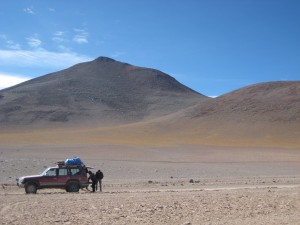
To me there was a very weird dynamic, actually, driving through southern Bolivia. In the midst of the empty countryside and strikingly impoverished little towns (groups of mud-brick buildings, really) and strikingly beautiful landscapes and waiting at llama crossings and more striking poverty (crumbling houses without roofs and solitary men out tending llamas in the middle of more completely empty land — 70% of the country’s population is rural, and the majority of people lack heating, electricity, and sometimes even running water) and so on,
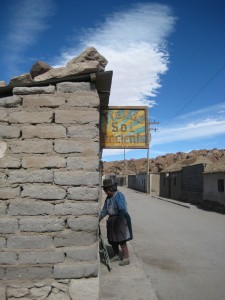
there were telephone lines everywhere, and the occasional industrial field with a foreign company on site and, oddly, road signs pointing us toward “pueblos auténticos” (“authentic towns”), a government-sponsored tourism project which had the paradoxical effect of suddenly making these pueblos seem very inauthentic (which I’m sure is not the case). (A quick internet search suggests that this guy designed the logo.) In other words, modernity and the state are staking their claims all over the countryside, but it hasn’t visibly affected the daily lives of the people (yet).
Anyway, I made the claim a few paragraphs ago that travel is difficult in Bolivia, and I should probably explain myself. Here’s the story: to save time and experience more of the country, we took an overnight bus from Uyuni to La Paz, about a nine-hour trip. We left at 9 pm. The bus came to a stop at 12 pm… and when we woke up the next morning, it still hadn’t moved. After an hour or so of continued confusion, the word slowly spread that we were in front of a bridge which had been taken over by striking peasants protesting something about land rights and waiting for the governor of the province to arrive to negotiate. They’d placed rocks all across the bridge to prevent traffic from passing.
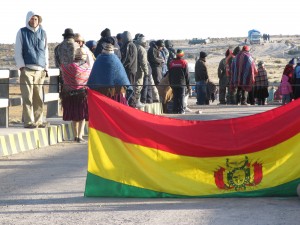
Long story short, after several more hours of waiting and getting all sorts of conflicting information (and translating for a group of British women who didn’t even have the advantage of speaking Spanish) and going to eat breakfast (galletas, a very useful word for anything small and cookie-shaped, be it cookie or cracker; a packet of Bolivian-made galletas generally cost one Boliviano — about fourteen cents), our group gave up and started walking. And walking.

And two hours and a few kilometers later, we reached the second paro (strike), where we found a very nice man who drove us to a nearby town (at that point, anywhere was fine); from that town, another driver very kindly took us to La Paz for about five dollars apiece. Twenty-seven hours later, our ordeal was over.
But here’s what I got out of this, besides the experience (adventure) of spending a night in what one friend termed the bus de pesadillas (bus of nightmares), and then that terrible trek across the empty countryside (word to the wise: packing fourteen kilos of clothes is almost certainly unnecessary if you have to carry it in a backpack): the state of Bolivia’s infrastructure is shocking. The reason we spent so long waiting and waiting and hoping that the negotiations would conclude, rather than just going around the bridge, is that there literally is no other road between Uyuni and La Paz. Go look it up on Google Maps (we were near Río Mulatos) — there is only one highway connecting that major tourist center (and essentially the only large town in southern Bolivia) and the de facto capital of the country.
Now, for everything else that made that week personal discomfort and long nights and entirely too many galletas completely worthwhile:
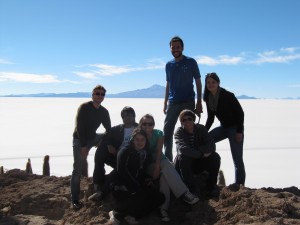
Isla Incahuasi, Salar de Uyuni -- in the middle of the largest salt-flats in the world, this "island" of rock emerges, inexplicably covered in enormous cacti.

Near the Hotel de Sal, in the middle of the salar.
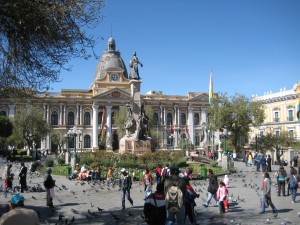
Plaza Murillo, La Paz
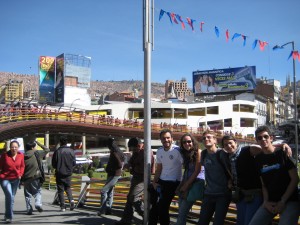
On our way to the Mercado de Hechicería (Witches' Market), La Paz.

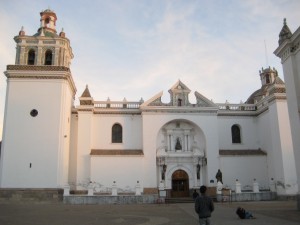
Iglesia de Copacabana, Copacabana (on the shores of Lake Titicaca) -- a major pilgrimage site during the colonial period

Inside the church -- that's all real silver and gold. (Photo credit: Murillo N.)
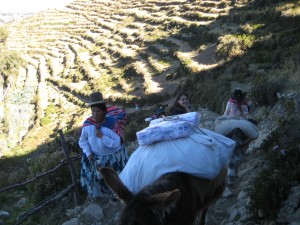
Isla del Sol, Lake Titicaca. Can you spot me?

The entire time we were in Bolivia, I was already thinking: “I can’t wait to come back. Five days isn’t remotely enough.”
Y, eso. I guess more than anything, I learned what it means to fall in love with a country on this trip. I like Chile a lot, and I really feel at home now in Santiago, but it didn’t knock me out at first sight. Bolivia, though, was incredible — I loved every part of it we saw.
And the most exciting thing about Bolivia is how full of possibilities it is (sorry for the cliché). Even after centuries of being strip-mined (the famous silver mine of Potosí is located a few hours away from Uyuni) and bled dry by Europe and the US, it’s still full of natural resources (gold, silver, copper, boron, magnetite, lithium, salt, and more) just waiting to be extracted; in such a poor country, this wealth of resources could be instrumental now in driving the country’s economic development.
Bolivia is also a deeply traditional country, especially outside of the cities, and more than 80% of the population claims indigenous identity; currently, Evo Morales, the country’s first indigenous president, is leading a push for political reform to better incorporate the Quechua, Aymara, Guaraní and some 33 other recognised indigenous groups into the, the state. A constitutional reform was passed in 2009 that changed the República de Bolivia into the Estado Plurinacional de Bolivia (and made more substantive and less cosmetic changes as well!), and Morales is now looking to reform the legal system to better protect indigenous rights. This program of political and social reform gets very little press in the US, but it’s one of the most interesting things going on in Latin America right now; Morales’ attempt to integrate such diverse cultures into the functioning of the state is the first of its kind, and his successes and failures in this program will have profound lessons for the rest of the continent.
(A few of my friends casually bumped into Evo as they were out picking up our laundry one evening in La Paz):
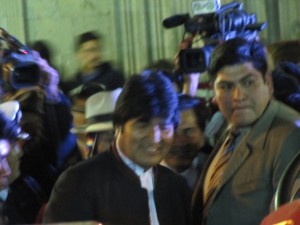
In other news, my flight home is on July 18; I can’t believe everything is coming to an end so quickly. I promise I’ll be back soon with more thoughts about Chile!
Comments
Leave a Reply


